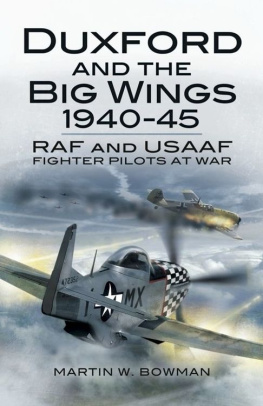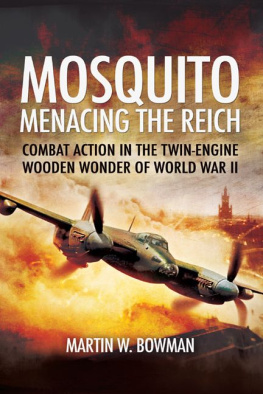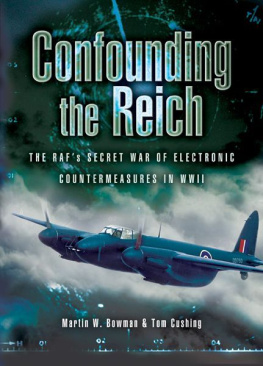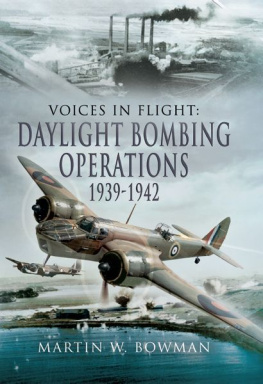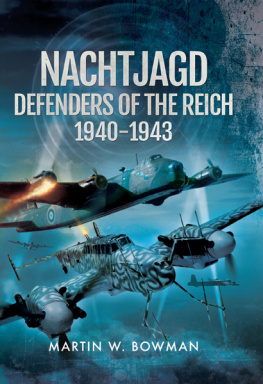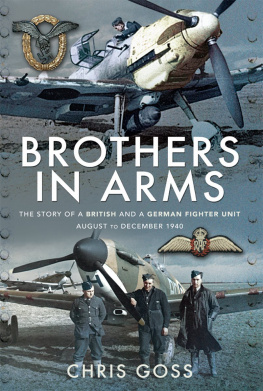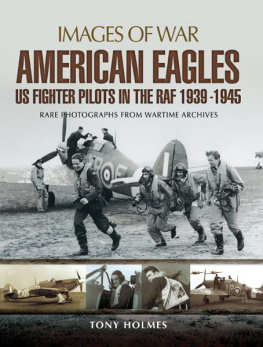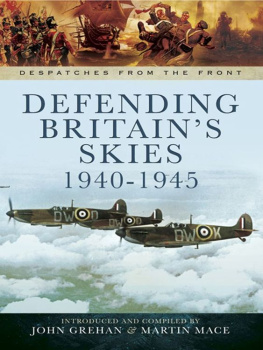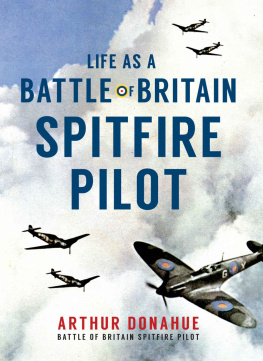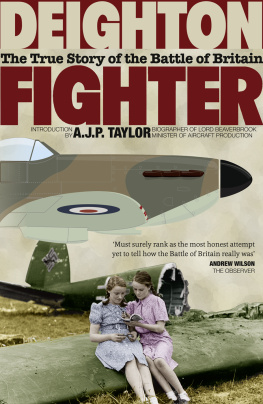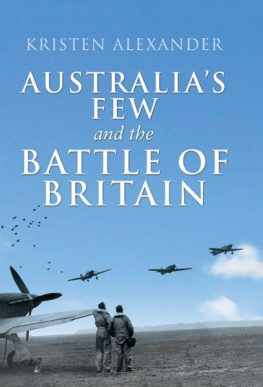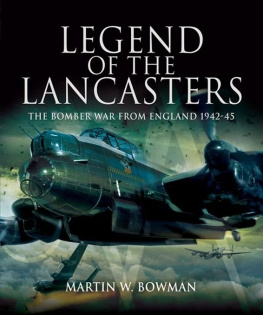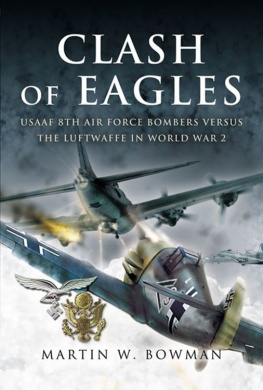First published in Great Britain in 2009 by
Pen & Sword Aviation
An imprint of
Pen & Sword Books Ltd
47 Church Street
Barnsley
South Yorkshire
S70 2AS
Copyright Martin W. Bowman 2009
9781783469505
The right of Martin W. Bowman to be identified as Author of this work has been asserted by him in accordance with the Copyright, Designs and Patents Act 1988.
A CIP catalogue record for this book is
available from the British Library
All rights reserved. No part of this book may be reproduced or transmitted in any form or by any means, electronic or mechanical including photocopying, recording or by any information storage and retrieval system, without permission from the Publisher in writing.
Printed and bound in England By Biddles
Pen & Sword Books Ltd incorporates the Imprints of Pen & Sword Aviation,
Pen & Sword Family History, Pen & Sword Maritime, Pen & Sword Military,
Wharncliffe Local History, Pen & Sword Select, Pen & Sword Military Classics,
Leo Cooper, Remember When, Seaforth Publishing and Frontline Publishing
For a complete list of Pen & Sword titles please contact
PEN & SWORD BOOKS LIMITED
47 Church Street, Barnsley, South Yorkshire, S70 2AS, England
E-mail: enquiries@pen-and-sword.co.uk
Website: www.pen-and-sword.co.uk
The author gratefully acknowledges permission to use extended quotations from:
Airfield Focus 1: Duxford by Andy Height (GMS 1992); Target of Opportunity: Tales & Contrails of the Second World War by Lieutenant Colonel R.A. Dick Hewitt (privately published, November 2000); A Mississippi Fighter Pilot In WWII by Lieutenant Colonel Ernest E Russell (Trafford Publishing (UK) Ltd 2008); Historic Tales of the Wild Blue Yonder by Larry Nelson (privately published 2006); Wandering Through World War II by Pete Keillor (privately published 2003). And I am no less grateful for the help given by Bob Collis; Air Commodore James Coward AFC; Andy Height; Lieutenant Colonel Richard Dick Hewitt; IWM Duxford; Pete Keillor; Huie Lamb; Lawrence Larry W Nelson; and Lieutenant Colonel Ernest Ernie Russell.
CHAPTER ONE
We Shall Defend Our Island
Even though large tracts of Europe and many old and famous States have fallen or may fall into the grip of the Gestapo and all the odious apparatus of Nazi rule, we shall not flag or fail. We shall go on to the end, we shall fight in France, we shall fight on the seas and oceans, we shall fight with growing confidence and growing strength in the air, we shall defend our island, whatever the cost may be, we shall fight on the beaches, we shall fight on the landing grounds, we shall fight in the fields and in the streets, we shall fight in the hills; we shall never surrender
Winston S Churchill
O n a raw November day in 1932 a young RAF fighter pilot drove his little red MG sports car along the winding A505 in Cambridgeshire to take up a new posting at Duxford airfield just south of the University City of Cambridge. This RAF fighter station forty miles north of London was home to 19 Squadron flying Bristol Bulldog IIA biplane fighters. At weekends the airfield hosted undergraduate members of the Cambridge University Air Squadron who were learning to fly and to become officers in the RAF. Duxford would normally have been a Mecca too for the twenty-two-year-old ex-RAF College Cranwell graduate, accomplished pilot and all-round sportsman who had flown Gloster Gamecocks in tied together aerobatics at Hendon air displays. But for Douglas Bader his posting to 19 Squadron was a bitter pill to swallow. Both his legs had been amputated following a horrific crash during low-level aerobatics at Reading Aero Club at Woodley airfield on 14 December 1931 when the wingtip of his Bulldog clipped the grass and the aircraft smashed into the ground. Lesser men would have died but expert medical care and his own tremendous fighting spirit and a strong will to live pulled him through. He endured the long ordeal of operations and rehabilitation and when given artificial legs Bader confounded the doctors who said that he would never walk unaided again. He not only proved them wrong, he proved to his RAF superiors that he could still fly aircraft, but the service was unable to pass him fit for flying because there was nothing in Kings Regulations which covered his case. Instead, he was posted to Duxford and on his arrival the wing commander in charge of the Station told him, Glad to have you here Bader. Youre taking over the Motor Transport Section.
In the 1930s Duxford was one of a few RAF stations that boasted permanent hangars and other buildings, brick barracks and mess sites and a large grass runway area. It was a far cry from 1914 18 when during the Great War military aviation really came of age and developments in weaponry and aircraft design made great strides and airfields had to be found to house the aircraft of the Royal Flying Corps. In England hundreds of potential sites were surveyed. One of them was on land north-west of the village of Duxford comprising 223 acres of land on the south side of the Newmarket to Royston road and fifteen acres on the other side of the road. Most of the land belonged to Temple Farm and College Farm. Once the survey was complete, the land was declared suitable and was requisitioned, as the RFC wanted to use Duxford as a training station. Tenders were invited from companies for the construction of the airfield, to include hangars, service buildings and living quarters for up to 800 personnel. In the summer of 1917, P & W Anderson, a Scottish civil engineering company, was given the contract to build the airfield and work began that October, at an estimated cost of 90,000. The buildings on the airfield site were mostly of brick and timber construction, but those on the domestic site on the north side of the road were mainly timber only. All materials were brought to the site from Whittlesford railway station, either by steam-driven lorries or horse-drawn wagons. The work progressed slowly and some of the roads showed signs of subsidence. Local people looked on with mixed feelings and complaints were made about the roads to the County Council and the Police. As the work progressed, more and more men were employed and at one stage it was estimated that a thousand men were working on the project. The cost of the work also began to rise but still progress was slow. In March 1918, United States Army personnel of the 159th Aero Squadron arrived to erect Bessonneaux hangars as a temporary measure to protect aircraft while the main hangars were completed. The permanent hangars would consist of three double-bay and one single-bay Belfast types with wooden concertina-type doors at each end. These buildings took the name from the wooden root trusses they incorporated.
As soon as the Bessonneaux hangars had been completed, the airfield was used as a mobilisation Station and 119, 123 and 129 Squadrons arrived in March and April 1918 with their DH 9 bomber aircraft. They were followed by the arrival of the American 151st, 256th and 268th Aero Squadrons but mostly they were put to work assembling aircraft and like Douglas Bader, fourteen years later, to running the Motor Transport Section. In July 1918 129 Squadron, now part of the Royal Air Force as the RFC had become on 1 April, disbanded. That July 35 Training Depot Station with a complement of 450 men and 158 women (the latter engaged in clerical and domestic work) opened as part of a new system of RAF pilot training. RAF Duxford did not open officially until September 1918 though the contractors work was still not finished. The Americans departed soon after Armistice Day, 11 November 1918, and the RAF and Britains other services were severely reduced in size and equipment. At Duxford building work was more or less complete but the cost had risen to 460,000 and an inquiry was convened to determine what had caused the delay in construction. Duxford remained a permanent post-war RAF station, however, to be used for flying training, and a survey carried out during late 1919 led to a further 355,000 being made available to update the station. Work involved re-roofing the hangars, constructing extra buildings and refurbishment of existing ones. While this work was in progress the aircraft was placed on a care and maintenance basis although in late 1919 No. 8 Squadron arrived from France to disband.

